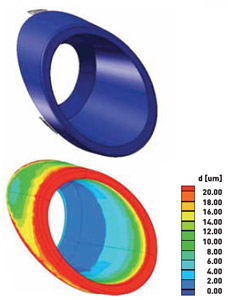Just as Moldflow has become indispensable to the plastic injection molding industry, so PlatingMaster simulations are becoming the norm for plating on plastics
This move has been catalyzed by the US auto industry’s refocus on quality and manufacturing risk elimination.
 For example, General Motors’ new standard for plated plastic parts (POP), GMW14668, recommends plating simulations where there is uncertainty of meeting minimum plating thicknesses due to part design features. For more difficult parts, such as license plate appliques (LPAs) there is a requirement for plating analysis – ‘Elsyca or equivalent approved’.
For example, General Motors’ new standard for plated plastic parts (POP), GMW14668, recommends plating simulations where there is uncertainty of meeting minimum plating thicknesses due to part design features. For more difficult parts, such as license plate appliques (LPAs) there is a requirement for plating analysis – ‘Elsyca or equivalent approved’.
Decorative POP is widely used in the automotive industry for internal and external trim such as handles, fog light bezels, trunk trim, decals and grilles. These components vary considerably in scale and complexity and can present significant challenges in mass production.
Plating in production is impacted on two scales. There is the explicit geometric shape of the single component where electrical current will distribute itself according to its shape, increasing near sharp edges and dropping off on large surfaces areas and recesses. Higher current densities lead to over plating (and material waste) whereas low current densities result in thin layers that may later lead to corrosion and warranty issues.
OEM standards specify the target thicknesses, however, in some cases these cannot be met unless the component is plated with the use of additional tooling such as shields, thieves or auxiliary anodes. It is essential therefore, to establish whether tooling will be required or not and then adjustments can be made to the project funding and timeline.
Plateability is a very quick analysis process. The CAD part is subjected to an envelope of current, consistent with the conditions in a plating tank. Typical specifications may call for a range 8-20μm nickel (depending on OEM and whether the part is internal or external). One can see from the picture at the top of this page that the nickel thickness is as low as 4μm in the recess. The OEM at this very early stage of design is immediately alerted to this manufacturing issue and with this knowledge can account for additional tooling in the supplier quoting and productionizing phase.
 The same plateability approach can be adopted by the supplier to identify technical and commercial risks in bidding for production. However, in order to make the job commercially viable, the supplier has to figure out a production solution. So really, the supplier has to answer the question, ‘what is the feasibility’ of plating this component to specification and at volume?’
The same plateability approach can be adopted by the supplier to identify technical and commercial risks in bidding for production. However, in order to make the job commercially viable, the supplier has to figure out a production solution. So really, the supplier has to answer the question, ‘what is the feasibility’ of plating this component to specification and at volume?’
Using the same technology and without the need for a physical prototype, the plating supplier can design and optimize the necessary tooling to plate the component within specifications.
Even though many simple components can plate well in isolation, there needs to be an analysis of the impact when plating multiple components mounted on a production rack.
This is key to commercial viability, as some components may not reach the specification due to their position on the rack. Pieces near the edges receive higher current densities on a local scale, since they have less neighbouring components. Again, this can be addressed at rack scale by including shields or thieves to ensure a 100% yield within specification.































